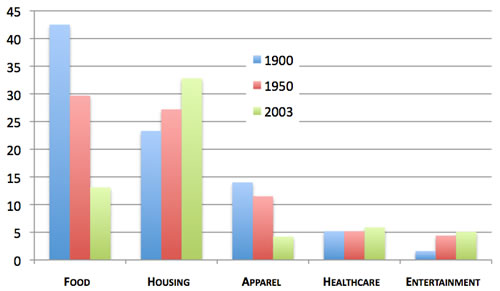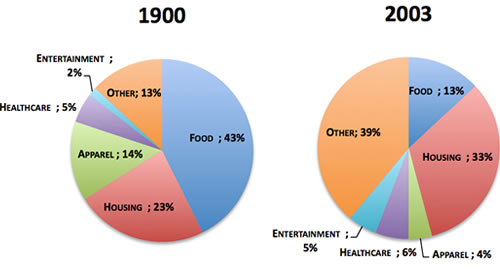Last week I mentioned comparing your budget with other people around the world. This time, how about comparing your budget to someone living 50 or 100 years ago?
A new article in The Atlantic dissects the information in a new government BLS report 100 Years of U.S. Consumer Spending, focusing on the the differences in spending in 1900, 1950, and 2003.

Source: The Atlantic magazine, Bureau of Labor Statistics
In 1900, nearly 60% of income went towards food and clothing. In 2003, food and clothing are now less than 20% of expenditures. Instead, more than half of income is spent on housing and transportation (included in Other). The percentage of healthcare costs is again deceiving, as today most healthcare expenses are not paid directly by consumers but instead by employer insurance premiums and programs like Medicare.

I don’t wish I lived in the 1900s, as I’m quite accustomed to high quality healthcare and flushing toilets. But we should realize that things are in constant change. Are we properly taking advantage of our mass-produced cheap clothing and agricultural advances? Or are we spending the difference on things we don’t need just to fill the gap? What will things look like in 2050?
 The Best Credit Card Bonus Offers – 2025
The Best Credit Card Bonus Offers – 2025 Big List of Free Stocks from Brokerage Apps
Big List of Free Stocks from Brokerage Apps Best Interest Rates on Cash - 2025
Best Interest Rates on Cash - 2025 Free Credit Scores x 3 + Free Credit Monitoring
Free Credit Scores x 3 + Free Credit Monitoring Best No Fee 0% APR Balance Transfer Offers
Best No Fee 0% APR Balance Transfer Offers Little-Known Cellular Data Plans That Can Save Big Money
Little-Known Cellular Data Plans That Can Save Big Money How To Haggle Your Cable or Direct TV Bill
How To Haggle Your Cable or Direct TV Bill Big List of Free Consumer Data Reports (Credit, Rent, Work)
Big List of Free Consumer Data Reports (Credit, Rent, Work)
What in the world is “other?” I look at the pie chart and everything I spend is listed on the chart, and the ratios are probably close to accurate. Could it be that “other” is money we spend on the government in the form of taxes?
Scott, I see several major items missing from the chart: Retirement savings, daycare, and college savings. If you add these items up, that is roughly 30% of my take home pay (and this does not include the payroll deduction for my wife and I’s 401k).
Umm.. there are a lot of things I spend money on that would be “other”: Auto, Gasoliine, Auto Insurance, Utilities, Computers, Housewares, Toilet Paper, etc etc
The Healthcare category alone is enough to call the rest of the data into question for me… I know most of the cost is paid for by employer insurance, but even the cost employees contribute to the premiums has been skyrocketing! How can such rapidly rising costs be in line with 100 years ago, much less 50?!
How can such rapidly rising costs be in line with 100 years ago, much less 50?!
Part of the answer is “as a percent of income”
This is a fascinating topic and of course it is really hard to have perfectly accurate answers and especially those that satisfy everyone. One point of reference – sewing used to be relatively common in households. These days it would seems like a silly waste of time to try making your own clothes.
In 1900 or 1950 the health care was RADICALLY different than today.
I mean how much medicine did they really have in 1900? They didn’t even have penicillin back then. There wasn’t much to medicine then by todays standards and thus little to pay for. Things advanced a lot by 1950 but they still didn’t have most of the modern medicine we have today, but by the 50’s health insurance was more common too.
Another detail: In 1900 the average family was 4.9 people but by 2003 the family was only 2.5 people. Another reason a higher % of spending goes to food and clothing.
It would be cool to see how the definition of family, spending and savings has changed over the past 100 years.
The most alarming change in consumer spending is the “Food” category. It’s hard to believe that in 1900, 43% of consumer spending was on food and today it’s only 13%! Although agriculture and technology have made food cheaper, I think it’s probably more an issue of priorities. People would rather have a nice TV and computer than spend their extra coin on Wholefoods. I always hear people talk about how overpriced it is and how they would rather save their money for other things when food is clearly the most important expenditure we have. I would love to see this % shift back up but I too am curious to see what the distribution is by 2050. At the current trajectory, we’ll be spending roughly 0% of our income on Food! Hope the trend changes directions…
Another thing… I think that the percentages mask the fact that one income was supporting the spending before, while now it is commonly two incomes.
They didn’t account for taxes? Seriously? The family earning ~60-90k per year will pay more in taxes than ANY other expense, and in some cases more than food and housing combined. They need to redraw these with taxes included — though that would paint a pretty grim picture.
In 1901 a bag of flour was 13 cents and family income averaged $750. So you could buy about 5769 bags of flour with a years income.
In 2003 a bag of flour was $1.56 and family income was $50,302. You could buy 32,244 bags of flour with 1 years income.
So comparing the cost of flour to the wages it costs about 1/6 as much of an average family’s income to buy flour in 2003 as it did in 1901.
I wonder how transportation fits in here. It’s interesting that our entertainment budget has more than doubled over the past century.
Sorry, but there’s no way we can compare our lives today to our ancestors. Too many variables.
It would be interesting to see a comparison with Canada’s numbers. Our housing prices are ridiculous.